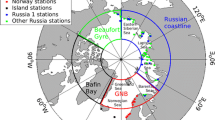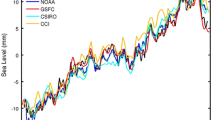Abstract
An historical objective analysis of subsurface temperature and salinity was carried out on a monthly basis from 1945 to 2003 using the latest observational databases and a sea surface temperature analysis. In addition, steric sea level changes were mainly examined using outputs of the objective analyses. The objective analysis is a revised version of Ishii et al. and is available at 16 levels in the upper 700 m depth. Artificial errors in the previous analysis during the 1990s have been worked out in the present analysis. The steric sea level computed from the temperature analysis has been verified with tide gauge observations and TOPEX/Poseidon sea surface height data. A correction for crustal movement is applied for tide gauge data along the Japanese coast. The new analysis is suitable for the discussion of global warming. Validation against the tide gauge reveals that the amplitude of thermosteric sea level becomes larger and the agreement improves in comparison with the previous analysis. A substantial part of local sea level rise along the Japanese coast appears to be explained by the thermosteric effect. The thermal expansion averaged in all longitudes from 60°S to 60°N explains at most half of recent sea level rise detected by satellite observation during the last decade. Considerable uncertainties remain in steric sea level, particularly over the southern oceans. Temperature changes within MLD make no effective contribution to steric sea level changes along the Antarctic Circumpolar Current. According to statistics using only reliable profiles of the temperature and salinity analyses, salinity variations are intrinsically important to steric sea level changes in high latitudes and in the Atlantic Ocean. Although data sparseness is severe even in the latest decade, linear trends of global mean thermosteric and halosteric sea level for 1955 to 2003 are estimated to be 0.31 ± 0.07 mm/yr and 0.04 ± 0.01 mm/yr, respectively. These estimates are comparable to those of the former studies.
Similar content being viewed by others
References
Antonov, J. I., S. Levitus and T. P. Boyer (2002): Steric sea level variations during 1957–1994: Importance of salinity. J. Geophys. Res., 107(C12), 8013, doi:10.1029/2001JC000964.
Antonov, J. I., S. Levitus and T. P. Boyer (2005): Thermosteric sea level rise, 1955–2003. Geophys. Res. Lett., 32, L12602, doi:10.1029/2005GL023112.
Boyer, T. P. and S. Levitus (1994): Quality Control and Processing of Historical Oceanographic Temperature, Salinity, and Oxygen Data. NOAA Technical Report NESDIS 81, 64 pp.
Boyer, T. P., M. E. Conkright, J. I. Antonov, O. K. Baranova, H. Garcia, R. Gelfeld, D. Johnson, R. Locarnini, P. Murphy, T. O. Brien, I. Smolyar and C. Stephens (2001): World Ocean Database 2001, Volume 2: Temporal Distribution of Bathythermograph Profiles. NOAA Atlas NESDIS 43, 119 pp., CD-ROM, U.S. Government Printing Office, Washington, D.C.
Boyer, T. P., S. Levitus, J. I. Antonov, R. A. Locarnini and H. E. Garcia (2005): Linear trends in salinity for the World Ocean, 1955–1998. Geophys. Res. Lett., 32, L01604, doi:10.1029/2004GL021791.
Cazenave, A. and R. S. Nerem (2004): Present-day sea level change: observations and cause. Rev. Geophys., 42, RG3001, doi:10.1029/2003RG000139.
Chambers, D. P., S. A. Hayes, J. C. Ries and T. J. Urban (2003): New TOPEX sea state bias models and their effect on global mean sea level. J. Geophys. Res., 108(C10), 3305, doi:10.1029/2003JC001839.
Church, J., J. M. Gregory, P. Huybrechts, M. Kuhn, K. Lambeck, M. T. Nhuan, D. Qin and P. L. Woodworth (2001): Changes in sea level. In Climate Change 2001: The Scientific Basis, Contribution of Working Group I to the Third Assessment Report of the Intergovernmental Panel on Climate Change, ed. by J. T. Houghton et al., Cambridge Univ. Press, New York.
Conkright, M. E., R. A. Locarnini, H. E. Garcia, T. D. O. Brien, T. P. Boyer, C. Stephens and J. I. Antonov (2001): World Ocean Atlas 2001: Objective Analyses, Data Statistics, and Figures. NOAA Atlas NESDIS 42, 17 pp., CD-ROM, U.S. Government Printing Office, Washington, D.C.
Derber, J. C. and A. Rosati (1989): A global oceanic data assimilation technique. J. Phys. Oceanogr., 19, 1333–1347.
Douglas, B. C. and W. R. Peltier (2002): The puzzle of global sea level rise. Phys. Today, 55, 35–40.
Ghil, M. and P. Malanotte-Rizzoli (1991): Data Assimilation in Meteorology and Oceanography. Advances in GEOPHYSICS, Vol. 33, Academic Press, p. 141–266.
Gill, A. E. (1982): Atmosphere-Ocean Dynamics. International Geophysics Series, Academic Press.
Gille, S. (2002): Warming of the southern ocean since the 1950s. Science, 295, 1275–1277.
Hanawa, K., P. Raul, R. Bailey, A. Sy and M. Szabados (1995): A new depth-time equation for Sippican or TSK T-7, T-6, and T-4 expendable bathythermographs (XBTs). Deep-Ses Res., 42, 1423–1451.
Hansen, D. V. and W. C. Thacker (1999): Estimation of salinity profiles in the upper ocean. J. Geophys. Res., 104(C4), 7921–7933.
Ishii, M., M. Kimoto and M. Kachi (2003): Historical ocean subsurface temperature analysis with error estimates. Mon. Wea. Rev., 131, 51–73.
Ishii, M., A. Shouji, S. Sugimoto and T. Matsumoto (2005): Objective analyses of SST and marine meteorological variables for the 20th century using ICOADS and the Kobe Collection. Int. J. Climatol., 25, 865–879.
Kuragano, T. and A. Shibata (1997): Sea surface dynamic height of the Pacific Ocean derived from TOPEX/POSEIDON altimeter data: Calculation method and accuracy. J. Oceanogr., 53, 585–599.
Levitus, S. (1982): Climatological Atlas of The World Ocean. NOAA Prof. Paper No. 13, 173 pp., U.S. Government Printing Office, Washington, D.C.
Levitus, S. (1989): Interpentadal variability of temperature and salinity at intermediate depths of the north Atlantic Ocean, 1970–74 versus 1955–1959. J. Geophys. Res., 94(C5), 6091–6131.
Levitus, S., C. Stephens, J. I. Antonov and T. P. Boyer (2000): Yearly and Year—Season Upper Ocean Temperature Anomaly Fields, 1948–1998. NOAA Atlas NESDIS 40 (available from http://www.nodc.noaa.gov/OC5/PDF/ATLAS/nesdis40.pdf).
Levitus, S., J. I. Antonov, T. P. Boyer, H. E. Garcia and R. A. Locarnini (2005a): Linear trends of zonally averaged thermosteric, halosteric, and total seteric sea level for individual ocean basins and the world ocean, (1955–1959)–(1994–1998). Geophys. Res. Lett., 32, L16601, doi:10.1029/2005GL023761.
Levitus, S., J. I. Antonov and T. P. Boyer (2005b): Warming of the world ocean, 1955–2003. Geophys. Res. Lett., 32, L02604, doi:10.1029/2004GL021592.
Lombard, A., A. Cazenave, P.-Y. Le Traon and M. Ishii (2005): Comtribution of thermal expansion to present-day sea-level change revisited. Global and Planetary Change, 47, 1–16.
Maes, C. and D. Behringer (2000): Using satellite-derived sea level and temperature profiles for determining the salinity variability: A new approach. J. Geophys. Res., 105(C4), 8537-8457.
Peltier, W. R. (2001): Global isostatic adjustment and modern instrumental records of relative sea level history, Chapter 4. In Sea Level Rise: History and Consequences, ed. by B. C. Douglas, M. S. Kearney and S. P. Leatherman, Academic Press, New York.
Reynolds, R. W. and T. M. Smith (1994): Improved global sea surface temperature analyses using optimum interpolation. J. Climate, 7, 929–948.
Reynolds, R. W., N. A. Rayner, T. M. Smith, D. C. Stokes and W. Wang (2002): An improved in-situ and satellite SST analysis for climate. J. Climate, 15, 1609–1625.
Stephens, C., S. Levitus, J. I. Antonov and T. P. Boyer (2001): The Pacific regime shift. Geophys. Res. Lett., 28, 3721–3724.
The Argo Science Team (1999): ARGO: The global array profiling floats. In Proceedings of the OOPC/UDP Ocean Obs Conference, Saint Raphaël, France, 18–22 October, 1999, 12 pp.
Vossepoel, F. C., R. W. Reynolds and L. Miller (1999): Use of sea level observations to estimate salinity variability in the tropical Pacific. J. Atmos. Ocean. Tech., 16, 1401–1415.
White, W. B. (1995): Design of a global observing system for gyre-scale upper ocean temperature variability. Prog. Oceanogr., 36, 169–217.
Willis, J. K., D. Roemmich and B. Cornuelle (2004): Interannual variability in upper ocean heat content, temperature, and thermosteric expansion on global scales. J. Geophys. Res., 109, C12036, doi: 10.1029/2003JC002260.
Author information
Authors and Affiliations
Corresponding author
Rights and permissions
About this article
Cite this article
Ishii, M., Kimoto, M., Sakamoto, K. et al. Steric sea level changes estimated from historical ocean subsurface temperature and salinity analyses. J Oceanogr 62, 155–170 (2006). https://doi.org/10.1007/s10872-006-0041-y
Received:
Revised:
Accepted:
Issue Date:
DOI: https://doi.org/10.1007/s10872-006-0041-y




